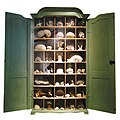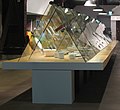The Museums Portal
A museum (/mjuːˈziːəm/ mew-ZEE-əm) is an institution dedicated to displaying and/or preserving culturally significant objects. Many museums have exhibitions of these objects on public display, and some have private collections that are used by researchers and specialists. Compared to a library, a museum hosts a much wider range of objects and usually focus around a specific theme such as the arts, science, natural history, local history, and other topics. Public museums that host exhibitions and interactive demonstrations are often considered to be tourist attractions, and many museums attract large numbers of visitors from outside their host country, with the most visited museums in the world regularly attracting millions of visitors annually.
Since the establishment of the earliest known museum in ancient times, museums have been associated with academia and the preservation of rare items. Museums originated as private collections of interesting items, and not until much later did the emphasis on educating the public take root. (Full article...)
Selected museum
The National Museum of African American History and Culture (NMAAHC), colloquially known as the Blacksonian, is a Smithsonian Institution museum located on the National Mall in Washington, D.C., in the United States. It was established in 2003 and opened its permanent home in 2016 with a ceremony led by President Barack Obama.
Early efforts to establish a federally owned museum featuring African-American history and culture can be traced to 1915 and the National Memorial Association, although the modern push for such an organization did not begin until the 1970s. After years of little success, a legislative push began in 1988 that led to authorization of the museum in 2003. A site was selected in 2006, and a design submitted by Freelon Group/Adjaye Associates/Davis Brody Bond was chosen in 2009. Construction began in 2012 and the museum completed in 2016.
The NMAAHC is the world's largest museum dedicated to African-American history and culture. In 2022 it welcomed 1,092,552 visitors, and was second-most visited Smithsonian Museum, and eighth in the List of most-visited museums in the United States. The museum has more than 40,000 objects in its collection, although only about 3,500 items are on display. The 350,000-square-foot (33,000 m2), 10 story building (five above and five below ground) and its exhibits have won critical praise. (Full article...)
Selected interior image
Selected general article

Heritage science is the interdisciplinary domain of scientific study of cultural and natural heritage. Heritage science draws on diverse humanities, sciences and engineering disciplines. It focuses on enhancing the understanding, care and sustainable use of heritage so it can enrich people's lives, both today and in the future. Heritage science is an umbrella term encompassing all forms of scientific enquiry into human works and the combined works of nature and humans, of value to people.
The above definition was developed though a community consultation organised by ICCROM and the European Research Infrastructure for Heritage Science in 2019. (Full article...)
Did you know...
- ... that the names of Harvey Meyerhoff, Elie Wiesel, and Bill Clinton are carved into the cornerstone of the United States Holocaust Memorial Museum, according to Meyerhoff's daughter?
- ... that a travelling museum exhibition in Japan displays "life-size" renditions of Pokémon skeletons alongside the fossils of actual prehistoric animals?
- ... that the Monument to the Victims of the Holocaust in Madrid was the first Holocaust memorial in Spain when it opened in 2007?
- ... that for the construction of the Mediterranean-style Jesús Soto Museum of Modern Art, architect Carlos Raúl Villanueva brought builders from Spain to Venezuela?
- ... that the lobby of Wenzhou Museum includes Kuafu chasing the sun and Chang'e flying to the moon?
- ... that the Seabury Tredwell House, now a museum, is Manhattan's only remaining 19th-century house with its original furnishings?
Get involved
For editor resources and to collaborate with other editors on improving Wikipedia's Museums-related articles, see WikiProject Museums.
Selected exterior image
Selected type of museum

Cabinets of curiosities (German: Kunstkammer and Kunstkabinett), also known as wonder-rooms (German: Wunderkammer), were encyclopedic collections of objects whose categorical boundaries were, in Renaissance Europe, yet to be defined. Although more rudimentary collections had preceded them, the classic cabinets of curiosities emerged in the sixteenth century. The term cabinet originally described a room rather than a piece of furniture. Modern terminology would categorize the objects included as belonging to natural history (sometimes faked), geology, ethnography, archaeology, religious or historical relics, works of art (including cabinet paintings), and antiquities. In addition to the most famous and best documented cabinets of rulers and aristocrats, members of the merchant class and early practitioners of science in Europe formed collections that were precursors to museums.
Cabinets of curiosities served not only as collections to reflect the particular curiosities of their curators but also as social devices to establish and uphold rank in society. There are said to be two main types of cabinets. As R. J. W. Evans notes, there could be "the princely cabinet, serving a largely representational function, and dominated by aesthetic concerns and a marked predilection for the exotic," or the less grandiose, "the more modest collection of the humanist scholar or virtuoso, which served more practical and scientific purposes." Evans goes on to explain that "no clear distinction existed between the two categories: all collecting was marked by curiosity, shading into credulity, and by some sort of universal underlying design". (Full article...)
Subcategories
Subtopics
Lists
- Museums
- Most visited museums (by region)
- Art museums: most visited, largest
Types
- Art museum
- Agricultural museum
- Archaeology museum
- Architecture museum
- Artillery museum
- Aviation museum
- Biographical museum
- Cabinet of curiosities
- Ceramics museum
- Children's museum
- Community museum
- Computer museum
- Design museum
- Dime museum
- Ecomuseum
- Economuseum
- Ethnographic village
- Farm museum
- Fashion museum
- Folk museum
- Food museum
- Green museum
- Hair museum
- Hall of Memory
- Heritage centre
- Historic house museum
- Human rights museum
- Imaginarium
- Interpretation centre
- Jewish museum
- Lapidarium
- Lighthouse museum
- Living museum
- Local museum
- Maritime museum
- Migration museum
- Mobile museum
- Museum ship
- National history museum
- Natural history museum
- Open-air museum
- Palace museum
- Postal museum
- Prefectural museum
- Print room
- Private museum
- Regimental museum
- Schatzkammer
- Science fiction libraries and museums
- Science museum
- Sex museum
- Sculpture garden
- Technology museum
- Textile museum
- Torture museum
- Toy museum
- Transport museum (list)
- University museum
- Virtual museum
- Wax museum
- Writer's home
Related
Associated Wikimedia
The following Wikimedia Foundation sister projects provide more on this subject:
-
 Commons
Commons
Free media repository -
 Wikibooks
Wikibooks
Free textbooks and manuals -
 Wikidata
Wikidata
Free knowledge base -
 Wikinews
Wikinews
Free-content news -
 Wikiquote
Wikiquote
Collection of quotations -
 Wikisource
Wikisource
Free-content library -
 Wikiversity
Wikiversity
Free learning tools -
 Wiktionary
Wiktionary
Dictionary and thesaurus
-

-

-

-

-
Random portal
Purge server cache




























































